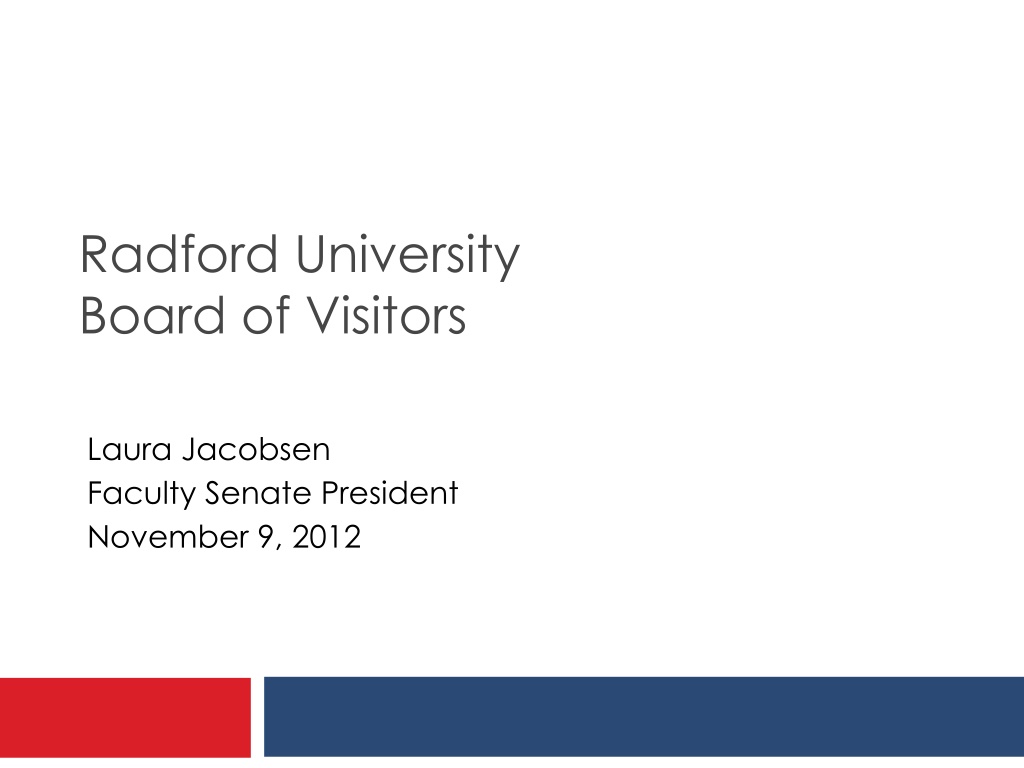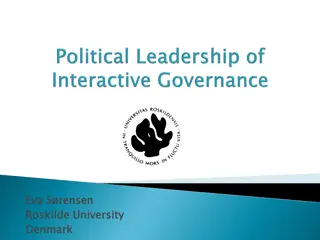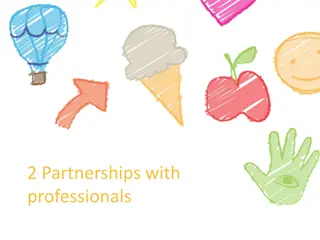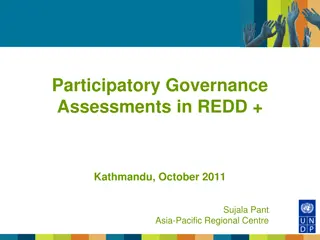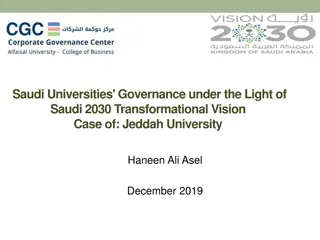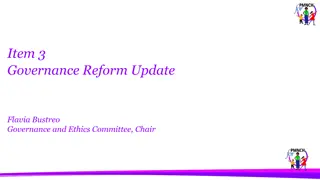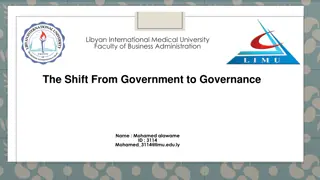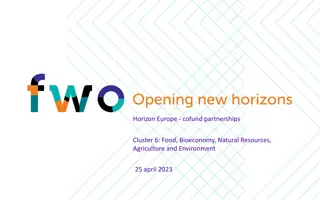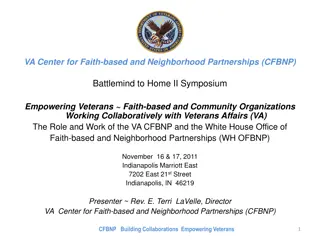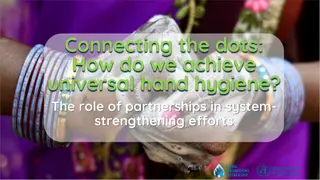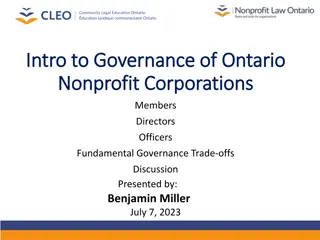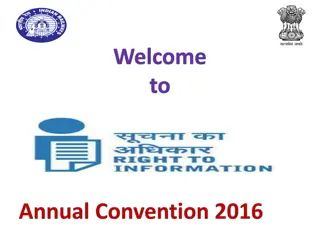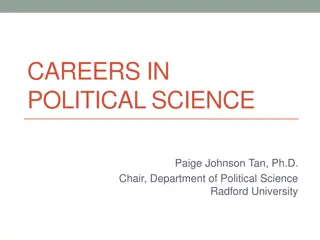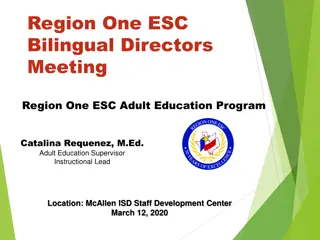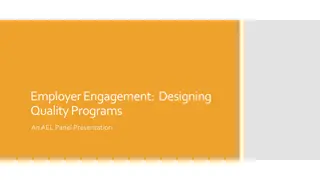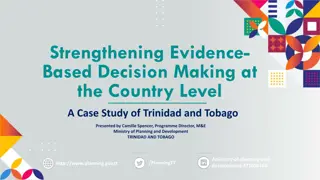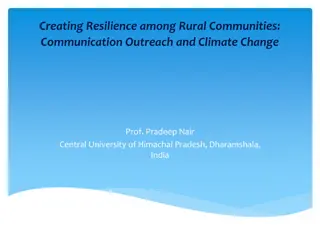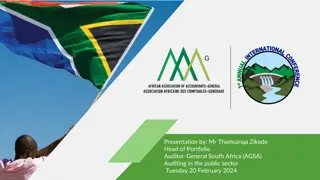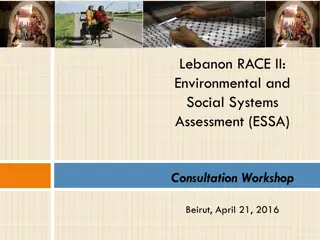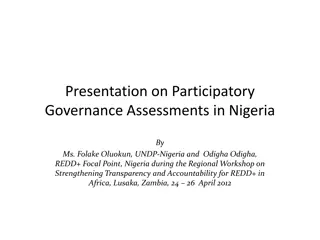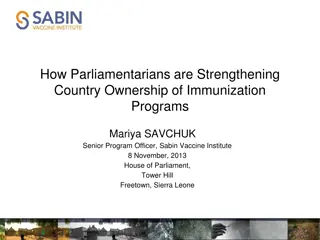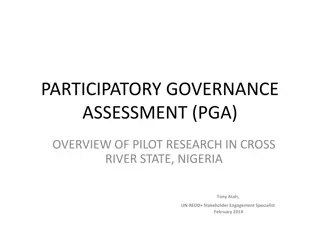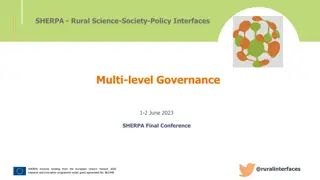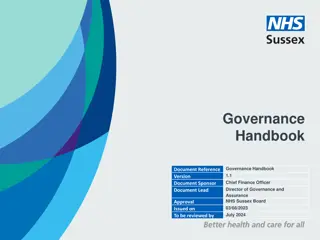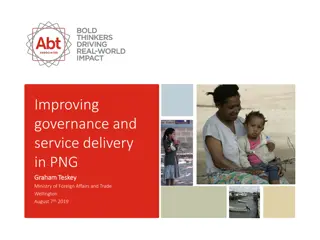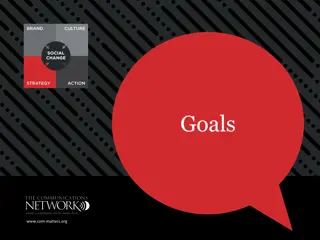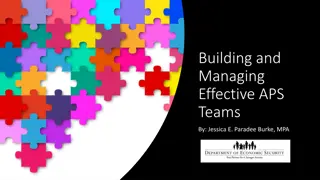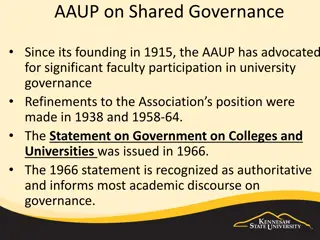Enhancing Governance at Radford University: Building Partnerships and Strengthening Communication
Focusing on fostering a healthy culture at Radford University, the Board of Visitors aims to improve governance by enhancing interactions between the board, faculty, and administration. The presentation highlights recommendations for building partnerships and broadening the scope of internal governance reform efforts, emphasizing the importance of effective communication and understanding among stakeholders.
Download Presentation

Please find below an Image/Link to download the presentation.
The content on the website is provided AS IS for your information and personal use only. It may not be sold, licensed, or shared on other websites without obtaining consent from the author. Download presentation by click this link. If you encounter any issues during the download, it is possible that the publisher has removed the file from their server.
E N D
Presentation Transcript
Radford University Board of Visitors Laura Jacobsen Faculty Senate President November 9, 2012
Focus of September Presentation Fostering a Healthy Culture Learn from recommendations of the Association of Governing Boards of Universities and Colleges Strengthen RU governance by encouraging meaningful interactions and improving relations between the Board of Visitors and faculty
Todays Presentation Fostering a Healthy Culture Revisiting the recommendations, in hopes we can begin to build partnerships Broadening the scope, in light of internal governance reform efforts
Hourglass Model Internal governance consultant, Rodney Smolla, referred to governance structures that pass communications through a President as using an hourglass model Not uncommon at institutions, but a weak model Communication is key Board of Visitors President Faculty, Administration, and Campus Community
Understanding One Another What do faculty do? Removing caricatures Most examples are from the AAUP: http://www.aaup.org/AAUP/issues/facwor k/facultydolist.htm
What Do Faculty Do? Image of a professor in a classroom lecturing to students Image of someone in a lab coat conducting an experiment According to the 1999 National Study of Postsecondary Faculty, published by the U.S. Department of Education's National Center for Education Statistics, full- time faculty members work about fifty-five hours a week, and part-time faculty work nearly forty. That figure includes paid and unpaid hours completed on and off campus. What might you find a professor doing if you followed him or her during the course of a day? http://www.aaup.org/AAUP/issues/facwork/facultydolist.htm
What Do Faculty Do? Examples of Student-Centered Work Creating or updating a new course or program Transitioning a course to an online format Helping students with subject matter in office hours or email Developing a class website or organizing a D2L site for a course Advising students about their coursework or choice of major Mentoring graduate students or directing their thesis committees Writing letters of recommendation Helping students to identify internships Reading and providing feedback on student research papers Establishing a study abroad program Sponsoring a student journal or advising a club Recruiting students into degree programs in their department
What Do Faculty Do? Examples of Disciplinary or Professional Centered Work Serving on a faculty search committee Evaluating a colleague's work for promotion or tenure Writing a journal article or book Participating in program assessment (e.g., Participating in data collection, analysis, and reporting for accreditation purposes) Reviewing potential library resources and advising on acquisitions Writing a recommendation for a colleague for a fellowship or award Serving on a committee that writes university policies Applying for a research or teaching grant or managing a grant Sponsoring a conference on campus Giving a scholarly presentation at an academic conference Editing a professional journal or reviewing submissions
What Do Faculty Do? Examples of Community-Centered Work Chairing a department or directing a degree program Giving a presentation to a business or school group, often at no expense to the group Providing professional advice to local, state, or national government Providing professional advice or consulting to associations, businesses, or community groups Helping to keep the public informed about issues by talking to the media Serving as an officer on the boards of local, state, or national group Partnering with other universities or school divisions on projects Presenting to the Board of Visitors
Building Relationships 7 recommendations made in September Thank you to the BOV Executive Committee for your thoughtful consideration and action related to those recommendations
Faculty Proposals to the BOV (from September meeting) Hold a BOV retreat with the faculty Town halls with all constituencies Invite faculty members to serve as members on each BOV committee Comments from guests at all committee meetings Create a new BOV Communications Committee that includes faculty, staff, and student representation Faculty Senate to discuss in further detail Focus on value-added activity
Faculty Proposals to the BOV (from September meeting) Revise BOV bylaws to defer to the faculty for determining who serves as faculty representative Faculty Senate of Virginia has drafted state legislation to require this. Will be seeking a sponsor. Same term limit as for Rector up to two consecutive terms Consideration: Beyond second term, the Faculty Senate Executive Council selects its new representative to the Board
Faculty Proposals to the BOV (from September meeting) Set aside time for a social event for faculty and staff to get to know BOV members This will happen; we will consider the timing Have BOV members participate in professional development offered through the Association of Governing Boards of Universities and Colleges Already involved Meet with consultant, Rodney Smolla, at February meeting This will happen
Internal Governance Reform Rodney Smolla visited on October 25-26 Met with all Senates and with the IG Task Force, chaired by Erin Webster-Garrett Highly informative debriefing, recommending start over He will provide a report with recommendations by November 15 The TIGR is moving forward
Governance and Management The question of who ultimately makes a decision is different from the question of who should be involved in the decision- making process E.g., Budget, curriculum, policies and procedures Involvement by representatives of affected constituencies, beginning at the planning stage, matters
Strengthening Community What matters? Structures, despite their imperfections Administrative convening of all committees by October 1 Processes and Communication Enhanced communications in budgetary and planning discussions across divisions. This includes within committees and within the President s Cabinet, and across administrative levels. Decision making process should be clear. Administrative accountability, not only for results, but also for adherence to each of the above Clear delineation of responsibilities for decision making, including clear responsibilities of the President
Effective Communication and Process Example: Summer School Challenges with summer school in 2012 FSEC proposed a new model for 2013 and invited and met twice with the AALT We did not reach consensus but did find some areas of agreement Eventual outcome remains unclear but is now less important Communications were not window dressing Voices were heard
Strengthening our Community Helps people better understand and trust each other Helps people feel in genuine partnership with one another Removes caricatures Builds both effectiveness and efficiency Students benefit when our university community is strong
